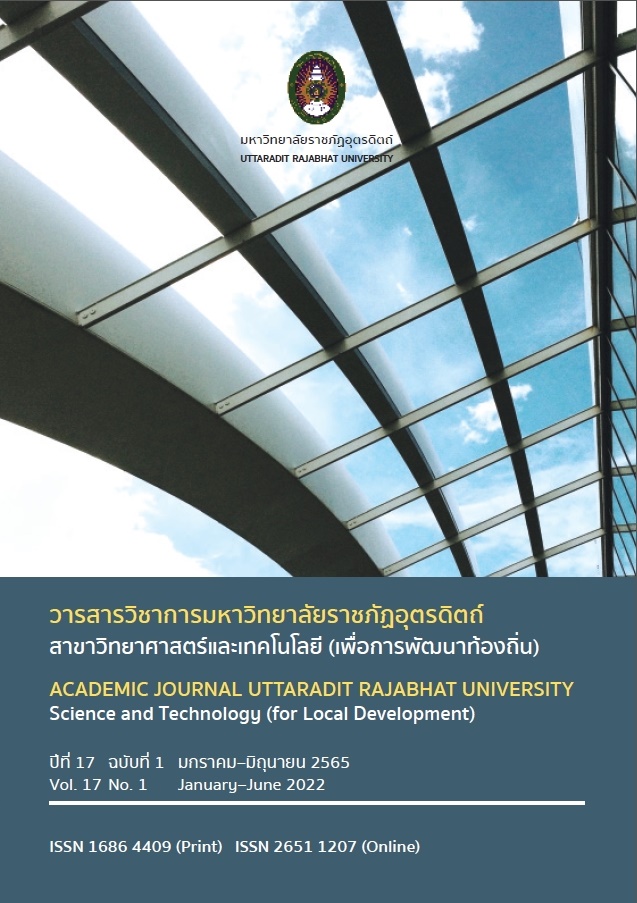ANALYSES OF THE TAMARIND PROCESSING MACHINERY’S PRODUCTION PROCESS CAPABILITY FOR COMMUNITY BUSINESSES Tamarind Processing Machinery
Main Article Content
Abstract
The purpose of this research was to analyze the capability of the production process of the Tamarind Processing Machinery for community businesses. The research was divided into 2 phases. Phase 1 was to take 1 kg of giant sour tamarind, which had been peeled and mixed with sugar, salt, and chili powder, and put it into the input channel for transport to the leaf set. Knife-cut tamarind
pieces with similar quality and faster than using manual labor. In the first round, one round of tamarind is cut, and in the second, two rounds of tamarind are cut. In each round, 200 g of tamarind are randomly selected from 1 production (1 kg of tamarind). The length of the tamarind is measured, and the tamarind is analyzed in the production process of the machine. Research found that to be defined as the qualifications and capabilities of machines, to produce 1 kg of tamarind, the machine takes an average of 1.04 minutes, which is 59.31 times faster than manual labor. The amount of loss of raw materials from the use of machines is approximately 6.67% more than that of manual labor, and the resulting work piece shape will not be as uneven as the production from labor. As for the process capability analysis, it was found that the capability of the production process was only at a confidence level of 95.45 percent, or at a level of 1–2. Increase production capacity, which can reduce time, reduce procedures, and reduce the amount of labor. Increase cleanliness standards in the production process, leading to higher standards of products and products. Increase confidence in the products of community businesses to be able to compete with the big competitors.
Downloads
Article Details

This work is licensed under a Creative Commons Attribution-NonCommercial-NoDerivatives 4.0 International License.
References
กลุ่มยุทธศาสตร์และสารสนเทศสำนักงานเกษตรจังหวัดเพชรบูรณ์. (2563). สถานการณ์ผลิตพืชจังหวัดเพชรบูรณ์ ปี 2563. สืบค้น 15 กรกฎาคม 2563, จาก http://www.phetchabun.doae.go.th/wp-content/uploads/2020/10/สถานการณ์การผลิตปี63-4.pdf
เทพ เพียมะลัง และ จินตนา สนามชัยสกุล. (2555). การศึกษาความต้องการมะขามเปรี้ยวเพื่อการแปรรูปและพัฒนาเทคนิควิธีการต่อยอดที่มีประสิทธิภาพโดยมีส่วนร่วมของกลุ่มเกษตรกรบ้านเหมืองแบ่ง ตำบลวังบาล อำเภอหล่มเก่า จังหวัดเพชรบูรณ์. รายงานการวิจัย. สำนักงานคณะกรรมการอุดมศึกษา.
รัฐพล ดุลยะลา. (2563). การออกแบบและพัฒนาเครื่องตัดกระยาสารทแบบกึ่งอัตโนมัติ. วารสารวิชาการมหาวิทยาลัยราชภัฏอุตรดิตถ์, 15(2), 117–131.
รัฐพล ท่อนแก้ว. (2557). แผนธุรกิจผลิตมะขามแช่อิ่มอบแห้ง. การค้นคว้าอิสระ. กรุงเทพฯ: มหาวิทยาลัยกรุงเทพ.
รุ่งเรือง ทารักษ์. (2553). การออกแบบและสร้างเครื่องตัดต้นหอม. ปริญญานิพนธ์อุตสาหกรรมศาสตรบัณฑิต มหาวิทยาลัยเทคโนโลยีราชมงคลล้านนา เขตพื้นที่ภาคพายัพ เชียงใหม่.
วิทยา หนูช่างสิงห์, นรัตน์ รัตนวัย, และ ธนภัทร มณีแสง. (2558). การออกแบบและสร้างเครื่องปั้นเนื้อมะขามแก้ว. ใน ปัญญา เลิศไกร (บ.ก.), สหวิทยาการ งานวิจัย และนวัตกรรมอุดมศึกษาเพื่อการพัฒนาท้องถิ่นไทย ก้าวไกลสู่อาเซียน, การประชุมวิชาการและนำเสนอผลงานวิจัยระดับชาติและนานาชาติ “ราชภัฏวิจัย ครั้งที่ 3”, (น. 104–110). นครศรีธรรมราช: มหาวิทยาลัยราชภัฏนครศรีธรรมราช.
สมพงษ์ สุขเขตต์. (2558). วิจัยและพัฒนามะขามเปรี้ยว รายงานโครงการวิจัยประจำปี 2558 กรมวิชาการทางเกษตร. สืบค้น 19 มิถุนายน 2563, จาก https://www.doa.go.th/research/attachment.php?aid=2171
Bhisham, C. G., & Walker, H. F. (2007). Statistical Quality Control for the Six Sigma Green Belt. Wisconsin: ASQ Quality.
Dangprasirt, P. (2005). Quality Control Chart. Pharmatime, 3(29), 63–71.
Douglas, C. M. (2013). Introduction to Statistical Quality Control. (7th ed.). NJ: Wiley.
Rehman, K. (2019). Six Sigma Statistics Using Minitab 17. Chicago: Independently Published.


